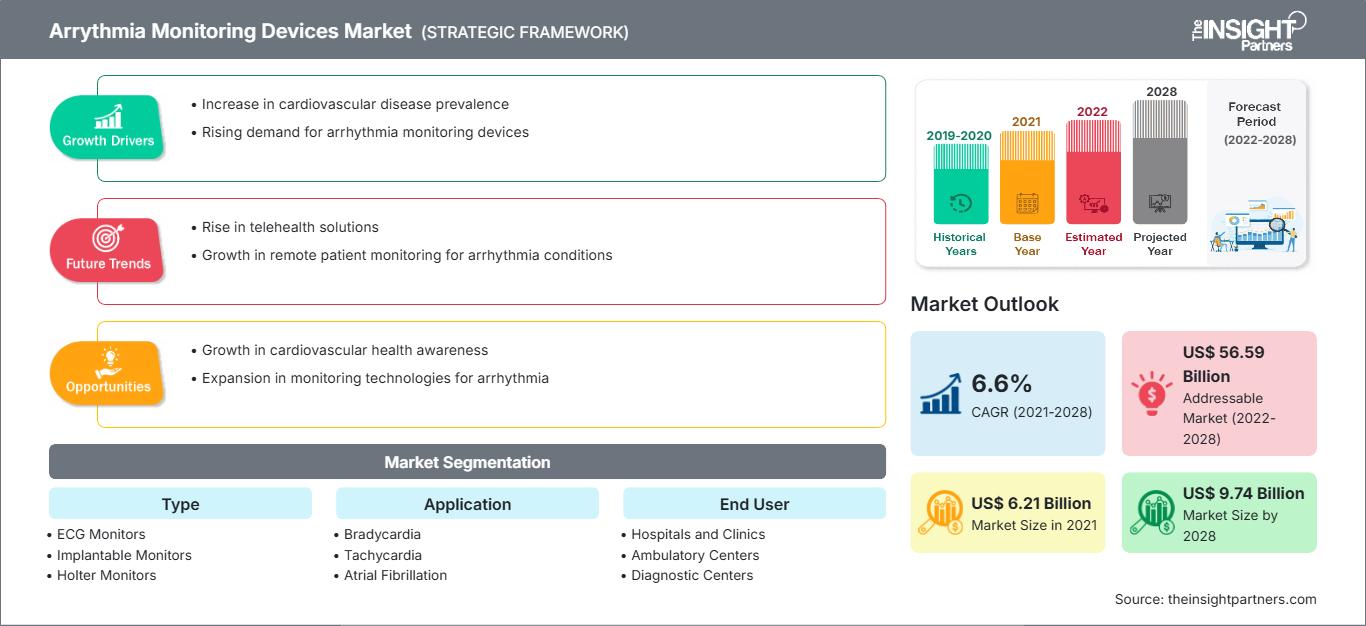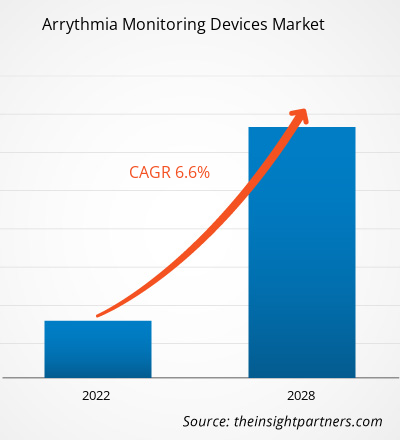Si prevede che il mercato dei dispositivi di monitoraggio dell'aritmia raggiungerà i 9.742,95 milioni di dollari entro il 2028, rispetto ai 6.212,59 milioni di dollari del 2021; si prevede una crescita a un CAGR del 6,6% dal 2021 al 2028.
L'aumento dell'incidenza delle malattie cardiovascolari e l'aumento della popolazione geriatrica sono i principali fattori che contribuiscono alla crescita del mercato. Tuttavia, l'elevato costo di prodotti e procedure ne frena la crescita. L'aritmia si riferisce a irregolarità del battito cardiaco, che possono causare un battito troppo rapido o lento. I dispositivi di monitoraggio dell'aritmia vengono utilizzati per monitorare la funzionalità cardiaca, mantenendo una registrazione continua della funzionalità cardiaca e segnalando eventuali anomalie del ritmo cardiaco.
I paesi dell'Asia-Pacifico stanno assistendo a un aumento dei casi di COVID-19. Come parte del suo impatto a breve termine, la pandemia di COVID-19 ha evidenziato la necessità di rivedere i processi normativi e apportare modifiche ai processi di ricerca e sviluppo. Inoltre, si è registrato un calo significativo delle visite ospedaliere e ambulatoriali per le catene ospedaliere private. Per alleviare i costi dei sistemi sanitari, molte cliniche hanno posticipato gli interventi chirurgici cardiaci non critici. Secondo un rapporto pubblicato sul British Journal of Surgery, il numero di interventi annullati in India è stimato a 48.728 a settimana. È probabile che questi eventi abbiano un impatto negativo sul mercato dei dispositivi di monitoraggio delle aritmie nell'area Asia-Pacifico.
Personalizza questo rapporto in base alle tue esigenze
Potrai personalizzare gratuitamente qualsiasi rapporto, comprese parti di questo rapporto, o analisi a livello di paese, pacchetto dati Excel, oltre a usufruire di grandi offerte e sconti per start-up e università
Mercato dei dispositivi di monitoraggio dell'aritmia: Approfondimenti strategici

-
Ottieni le principali tendenze chiave del mercato di questo rapporto.Questo campione GRATUITO includerà l'analisi dei dati, che vanno dalle tendenze di mercato alle stime e alle previsioni.
Nell'ultimo decennio, il mondo ha assistito a notevoli sviluppi nei dispositivi di monitoraggio dell'aritmia, offrendo a medici e pazienti nuovi approcci per la gestione di numerose patologie, tra cui aritmie atriali, aritmie ventricolari e fibrillazione atriale ventricolare. La crescente prevalenza di aritmie e altre malattie cardiovascolari (MCV) come bradicardia, tachicardia, fibrillazione atriale, fibrillazione ventricolare e contrazione prematura sta incoraggiando l'introduzione di metodi diagnostici migliorati. I sistemi di monitoraggio cardiaco sono strumenti più semplici e rapidi utilizzati per rilevare le aritmie, il che ha contribuito alla loro popolarità. Secondo l'Organizzazione Mondiale della Sanità (OMS), le MCV sono tra le principali cause di morte in tutto il mondo e circa 30 milioni di persone sono colpite da ictus ogni anno. Secondo l'American Heart Association, quasi la metà degli adulti negli Stati Uniti soffre di una MCV. Inoltre, si prevede che oltre 130 milioni di persone, ovvero il 45,1% della popolazione statunitense, saranno affette da una qualche forma di malattia cardiovascolare entro il 2035. Inoltre, i cambiamenti nello stile di vita portano all'aumento dell'incidenza di malattie come diabete, ipertensione, dislipidemia e obesità, contribuendo a un aumento dei casi di malattie cardiovascolari in tutto il mondo. La maggior parte delle malattie cardiovascolari può essere prevenuta attraverso il pre-monitoraggio e la pre-diagnosi. Allo stesso modo, le aritmie, ovvero le anomalie del funzionamento cardiaco, possono essere evitate con una diagnosi precoce. La domanda di dispositivi per il monitoraggio delle aritmie è in aumento, poiché questi dispositivi possono contribuire a salvare i pazienti ad alto rischio di arresto cardiaco. Approfondimenti basati sulla tipologia di aritmia: in base alla tipologia, il mercato dei dispositivi per il monitoraggio delle aritmie è segmentato in monitor ECG, monitor impiantabili, monitor Holter, telemetria cardiaca mobile e altri. Il segmento dei monitor Holter ha detenuto la quota maggiore di mercato nel 2020. I monitor Holter sono una delle scelte più preferite per il monitoraggio cardiaco. Inoltre, questi dispositivi possono essere utilizzati a lungo termine per la diagnosi di sintomi sporadici e offrono un monitoraggio più rapido e pratico. Tuttavia, si prevede che il segmento della telemetria cardiaca mobile crescerà al CAGR più elevato tra il 2021 e il 2028.
Approfondimenti basati sulle applicazioni
In base all'applicazione, il mercato dei dispositivi di monitoraggio dell'aritmia è segmentato in bradicardia, tachicardia, fibrillazione atriale, fibrillazione ventricolare, contrazione prematura e altri. Il segmento della fibrillazione atriale ha detenuto la quota maggiore di mercato nel 2020 e si stima che registrerà il CAGR più elevato durante il periodo di previsione. La crescita del mercato nel segmento della fibrillazione atriale può essere attribuita all'aumento della prevalenza della fibrillazione atriale e all'invecchiamento della popolazione.
Informazioni basate sull'utente finale
In base all'utente finale, il mercato dei dispositivi di monitoraggio dell'aritmia è segmentato in ospedali e cliniche, centri ambulatoriali, centri diagnostici e altri. Il segmento ospedali e cliniche ha detenuto la quota maggiore del mercato nel 2020. Il crescente numero di ospedali multispecialistici e la preferenza delle persone per gli ospedali rispetto ad altre strutture sanitarie sono i principali fattori che guidano la crescita del mercato nel segmento ospedali e cliniche. Tuttavia, si prevede che il segmento dei centri ambulatoriali registrerà il CAGR più elevato sul mercato durante il periodo di previsione.Le aziende che operano nel mercato dei dispositivi di monitoraggio dell'aritmia si concentrano sull'adozione di una strategia di innovazione di prodotto per soddisfare le mutevoli esigenze dei clienti in tutto il mondo, il che consente loro anche di mantenere il proprio marchio nel mercato globale.
Approfondimenti regionali sul mercato dei dispositivi di monitoraggio dell'aritmia
Le tendenze regionali e i fattori che influenzano il mercato dei dispositivi di monitoraggio dell'aritmia durante il periodo di previsione sono stati ampiamente spiegati dagli analisti di The Insight Partners. Questa sezione illustra anche i segmenti di mercato e la distribuzione geografica dei dispositivi di monitoraggio dell'aritmia in Nord America, Europa, Asia-Pacifico, Medio Oriente e Africa, America meridionale e centrale.
Ambito del rapporto di mercato sui dispositivi di monitoraggio dell'aritmia
| Attributo del rapporto | Dettagli |
|---|---|
| Dimensioni del mercato in 2021 | US$ 6.21 Billion |
| Dimensioni del mercato per 2028 | US$ 9.74 Billion |
| CAGR globale (2021 - 2028) | 6.6% |
| Dati storici | 2019-2020 |
| Periodo di previsione | 2022-2028 |
| Segmenti coperti |
By Tipologia
|
| Regioni e paesi coperti |
Nord America
|
| Leader di mercato e profili aziendali chiave |
|
Densità degli operatori del mercato dei dispositivi di monitoraggio dell'aritmia: comprendere il suo impatto sulle dinamiche aziendali
Il mercato dei dispositivi per il monitoraggio dell'aritmia è in rapida crescita, trainato dalla crescente domanda degli utenti finali, dovuta a fattori quali l'evoluzione delle preferenze dei consumatori, i progressi tecnologici e una maggiore consapevolezza dei benefici del prodotto. Con l'aumento della domanda, le aziende stanno ampliando la propria offerta, innovando per soddisfare le esigenze dei consumatori e sfruttando le tendenze emergenti, alimentando ulteriormente la crescita del mercato.

- Ottieni il Mercato dei dispositivi di monitoraggio dell'aritmia Panoramica dei principali attori chiave
- Monitor ECG
- Monitor impiantabili
- Monitor Holter
- Telemetria cardiaca mobile
- Altri
Mercato dei dispositivi di monitoraggio dell'aritmia: per applicazione
- Bradicardia
- Tachicardia
- Fibrillazione atriale
- Fibrillazione ventricolare
- Contrazione prematura
- Altre applicazioni
Mercato dei dispositivi di monitoraggio dell'aritmia: per utente finale
- Ospedali e cliniche
- Centri ambulatoriali
- Centri diagnostici
- Altri utenti finali
Mercato dei dispositivi di monitoraggio dell'aritmia: per area geografica
-
America settentrionale
- Stati Uniti
- Canada
- Messico
-
Europa
- Francia
- Germania
- Italia
- Regno Unito
- Spagna
- Resto d'Europa
-
Asia Pacifico (APAC)
- Cina
- India
- Corea del Sud
- Giappone
- Australia
- Resto dell'APAC
-
Medio Oriente e Africa (MEA)
- Sudafrica
- Arabia Saudita
- EAU
- Resto del MEA
-
America meridionale e centrale (SCAM)
- Brasile
- Argentina
- Resto di SCAM
Profili aziendali
- Abbott
- Koninklijke Philips NV
- General Electric Company
- Hill-Rom Holding Inc.
- Medtronic
- Biotronik, Inc.
- AliveCor, Inc
- ACS Diagnostics
- Medicalgorithmics
- OSI Systems, Inc
- Analisi storica (2 anni), anno base, previsione (7 anni) con CAGR
- Analisi PEST e SWOT
- Valore/volume delle dimensioni del mercato - Globale, Regionale, Nazionale
- Industria e panorama competitivo
- Set di dati Excel
Report recenti
Testimonianze
Motivo dell'acquisto
- Processo decisionale informato
- Comprensione delle dinamiche di mercato
- Analisi competitiva
- Analisi dei clienti
- Previsioni di mercato
- Mitigazione del rischio
- Pianificazione strategica
- Giustificazione degli investimenti
- Identificazione dei mercati emergenti
- Miglioramento delle strategie di marketing
- Aumento dell'efficienza operativa
- Allineamento alle tendenze normative






















 Ottieni un campione gratuito per - Mercato dei dispositivi di monitoraggio dell'aritmia
Ottieni un campione gratuito per - Mercato dei dispositivi di monitoraggio dell'aritmia